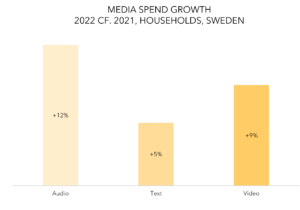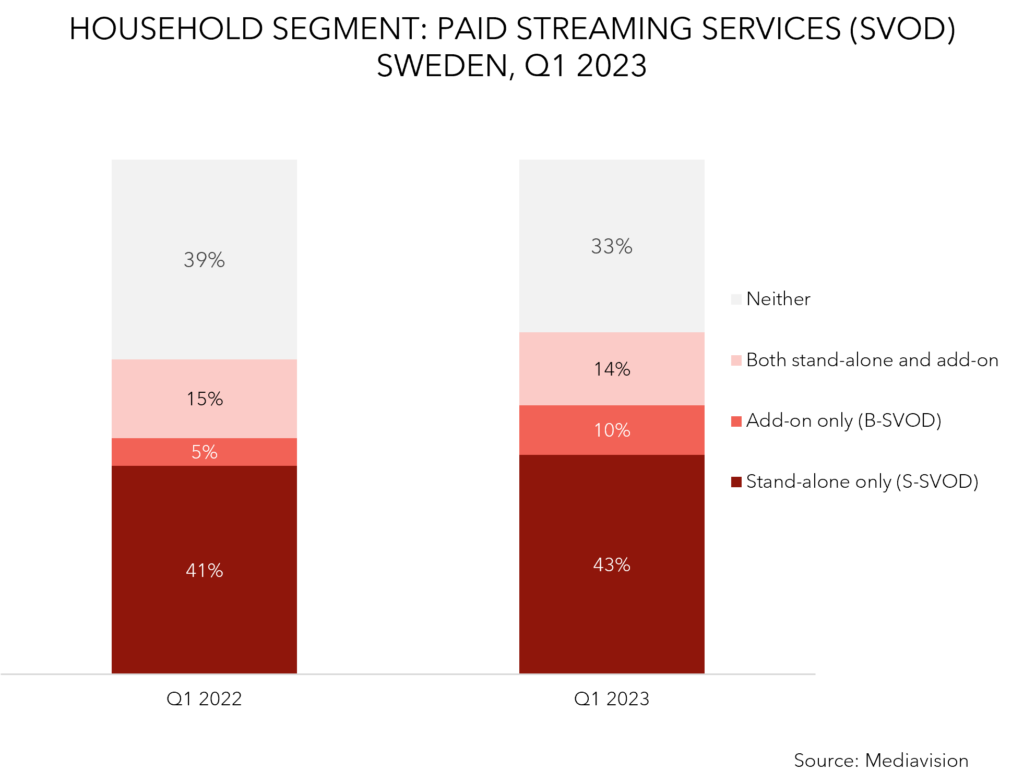Swedish media is mainly financed by advertising and consumer payments. The advertising market is largely affected in an economic downturn. However, Mediavision can show that households’ interest in paying for media, for example through subscriptions, continues to increase – despite the economic decline. For many media companies, consumer revenues will increase in importance if Sweden enters a recession.
Swedish household media spend has gradually increased and despite economic concerns, 2022 was no exception. Average media spend increased 8 percent compared to 2021, and now amounts to SEK 685 per month. Looking across the three main categories text, audio and video1, audio services increased the most, with a whopping 12 percent. At the same time, text grew by 5 percent and video by 9 percent compared to 2021. For the advertising market, development was significantly weaker and, according to IRM, a decrease of just over 2 percent was noted in the last quarter of the year, compared to the same period in 2021.

For advertising revenue in 2023, IRM expects a continued decline of 0.7 percent. For consumer payments, Mediavision currently sees no signs of a similar decline. On the contrary, preliminary data for the first months of the year shows continued growth. Bottom line is that consumer payments are stable or increasing, despite economic instability. When consumers are asked about their plans in financially tougher times, other expenses than media are opted out first.
– We recognize this pattern from previous economic downturns. Household spend on media is more stable than advertising revenue, comments Marie Nilsson, CEO at Mediavision. Therefore, it is particularly important in these times to closely monitor, for example, customer satisfaction and price sensitivity. Bundling different types of media services can also be a way to strengthen the relationship with consumers.
¹Text: Digital/printed newspapers, magazines and books (subscription and purchase per unit) Audio: audiobooks, music and podcasts (subscription and purchase per unit) Video: Trad. TV, SVOD, TVOD, cinema and DVD/Blu-ray.
During the first quarter of 2023, growth is again noted for paid streaming services, so-called SVOD. This comes after a clear slowdown during last year. The fact that more households now choose to buy streaming subscriptions is primarily explained by the fact that the subscriptions are bundled with pay TV. This is concluded by Mediavision in the latest analysis of the Swedish streaming market.
Household penetration for paid streaming services in Sweden increased by 9 percent in the first quarter, compared to the same period in 2022. This is a shift, after a period of relatively slow growth. Today, close to 70 percent of households in Sweden have at least one paid streaming service, either as a stand-alone subscription or bundled with another service (Buy through SVOD or B-SVOD, in short), usually pay TV. It is mainly these bundled offers that are now driving growth. This type of subscription increased by a whopping 15 percent in Q1 and is now found in every fourth household.

It is primarily households that previously did not have paid streaming services that are now attracted by this new type of packaging. TV operators, such as Telia and Tele2, have broadly launched streaming content alongside their traditional TV offerings. These bundles are perceived as good value which has likely had an impact on uptake. Subscriptions that are bundled with another service are usually less expensive than buying them separately.
– Bundled offers have developed rapidly, with an increasing number of offerings from more TV operators. We now see that these packages are also attracting brand new households, which previously did not have paid streaming services. There are many indications that this trend will continue, as it has driven both increased access and market turnover, says Marie Nilsson, CEO at Mediavision.
